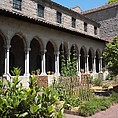Cloister
Reconstructed with twenty-one double capitals surmounting slender columns, the L-shaped arcade of this cloister screens the delightful herb garden of the Museum. The decorations of the capitals fall loosely into two groups: those with bulbous leaves forming prominent volutes at the corners (sometimes in two registers), and those with large, flattened foliage hugging the body of the capitals. Traditionally thought to have come from a Cistercian monastery in Bonnefont-en-Comminges near Toulouse, at least nine of the double capitals (six installed here, one in the Trie Cloister, and two in storage) are now known to have come from a late thirteenth-century Franciscan monastery in Tarbes that was demolished in 1907–8. Stylistic analyses of the remaining sculptures support the long-held belief that they came from other monuments in this region.
Not copied after any specific model, the layout of the cloister garden approximates that of a medieval herb garden, with raised beds bordered by bricks and wattle fences. Grouped and labeled according to their medieval usage (e.g., medicinal, culinary, magic, household), all of the plants grown in the garden are species documented in medieval sources, such as the ninth-century Capitulare de villis vel curtis imperialibus (Directive for the Administration of Imperial Courts). Of particular interest are the plants used by medieval artists, including those providing pigments for manuscript painting and textile dyeing.
#38. Cloister
Due to rights restrictions, this image cannot be enlarged, viewed at full screen, or downloaded.









